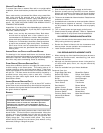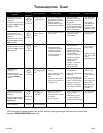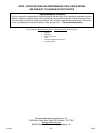
27
IO-242C 05/05
Use the following precautions during furnace installation and
servicing to protect the integrated control module from damage.
By putting the furnace, the control, and the person at the same
electrostatic potential, these steps will help avoid exposing the
integrated control module to electrostatic discharge. This procedure
is applicable to both installed and uninstalled (ungrounded)
furnaces.
1. Disconnect all power to the furnace. Do not touch the
integrated control module or any wire connected to the
control prior to discharging your body’s electrostatic charge
to ground.
2. Firmly touch a clean, unpainted, metal surface of the
furnace away from the control. Any tools held in a person’s
hand during grounding will be discharged.
3. Service integrated control module or connecting wiring
following the discharge process in step 2. Use caution
not to recharge your body with static electricity; (i.e., do not
move or shuffle your feet, do not touch ungrounded objects,
etc.). If you come in contact with an ungrounded object,
repeat step 2 before touching control or wires.
4. Discharge your body to ground before removing a new
control from its container. Follow steps 1 through 3 if
installing the control on a furnace. Return any old or new
controls to their containers before touching any ungrounded
object.
DIAGNOSTIC CHART
Refer to the troubleshooting chart on the following pages for
assistance in determining the source of unit operational problems.
The red diagnostic LED blinks to assist in troubleshooting the
unit. The number of blinks refer to a specific code.
RESETTING F ROM L OCKOUT
Furnace lockout results when a furnace is unable to achieve
ignition after three attempts, or when it has lost flame five times
during a single call for heat. It is characterized by a non-functioning
furnace and a one flash diagnostic LED code from the red LED. If
the furnace is in “lockout”, it will (or can be) reset in any of the
following ways.
1. Automatic reset. The integrated control module will
automatically reset itself and attempt to resume normal
operations following a one hour lockout period.
2. Manual power interruption. Interrupt 115 volt power to the
furnace for 0 - 20 seconds.
3. Manual thermostat cycle. Lower the thermostat so that
there is no longer a call for heat for 0 - 20 seconds then
reset to previous setting.
NOTE: If the condition which originally caused the lockout still
exists, the control will return to lockout. Refer to the Diagnostic
Chart for aid in determining the cause.
XVI. MAINTENANCE
WARNING
TO AVOID ELECTRICAL SHOCK, INJURY OR DEATH, DISCONNECT ELECTRICAL
POWER BEFORE PERFORMING ANY MAINTENANCE. IF YOU MUST HANDLE THE
IGNITER, HANDLE WITH CARE.
T
OUCHING THE IGNITER ELEMENT WITH BARE
FINGERS, ROUGH HANDLING, OR VIBRATION COULD DAMAGE THE IGNITER
RESULTING IN PREMATURE FAILURE.
O
NLY A QUALIFIED SERVICER SHOULD
EVER HANDLE THE IGNITER.
ANNUAL INSPECTION
The furnace should be inspected by a qualified installer, or service
agency at least once per year. This check should be performed at
the beginning of the heating season. This will ensure that all
furnace components are in proper working order and that the
heating system functions appropriately. Pay particular attention to
the following items. Repair or service as necessary.
• Flue pipe system. Check for blockage and/or leakage.
Check the outside termination and the connections at and
internal to the furnace.
• Heat exchanger. Check for corrosion and/or buildup within
the heat exchanger passageways.
• Burners. Check for proper ignition, burner flame, and flame
sense.
• Wiring. Check electrical connections for tightness and/or
corrosion. Check wires for damage.
• Filters.
FILTERS
WARNING
T
O AVOID PROPERTY DAMAGE, PERSONAL INJURY OR DEATH, DISCONNECT
ELECTRICAL POWER BEFORE REMOVING FILTERS.
N
EVER OPERATE FURNACE
WITHOUT A FILTER INSTALLED BECAUSE DUST AND LINT WILL BUILD UP ON
INTERNAL PARTS RESULTING IN LOSS OF EFFICIENCY, EQUIPMENT DAMAGE
AND POSSIBLE FIRE.
A return air filter is not supplied with this furnace; however, there
must be a means of filtering all of the return air. The installer will
supply filter(s) at the time of installation.
FILTER M AINTENANCE
Improper filter maintenance is the most common cause of
inadequate heating or cooling performance. Filters should be
cleaned (permanent) or replaced (disposable) every two months
or as required. When replacing a filter, it must be replaced with a
filter of the same type and size.
WARNING
T
O PREVENT PROPERTY DAMAGE, PERSONAL INJURY OR DEATH DUE TO
ELECTRICAL SHOCK, DISCONNECT ELECTRICAL POWER TO THE FURNACE
BEFORE REMOVING THE FILTER OR PERFORMING ANY OTHER MAINTENANCE.
Become familiar with filter location and procedures for removal,
cleaning and replacing them. If help is needed, contact the installer
of the furnace or a qualified servicer.
FILTER REMOVAL
Depending on the installation, differing filter arrangements can
be applied. Filters can be installed in either the central return
register or a side panel external filter rack (upflow only). A media
air filter or electronic air cleaner can be used as an alternate filter.
Follow the filter sizes given in the Recommended Minimum Filter
size table to ensure proper unit performance.
To remove filters from an external filter rack in an upright upflow
installation, follow the directions provided with external filter rack
kit. To remove internal filters see Internal Filter Removal section.
Internal filters are an accessory item and are not included with
your furnace. For further details, see your distributor.


















